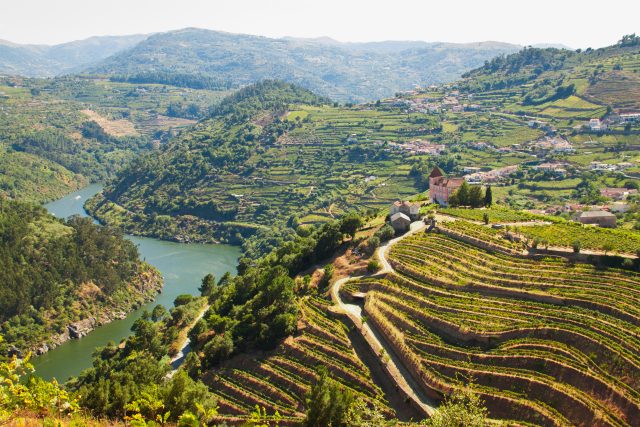The Douro hits crisis point
Beleaguered growers in the Douro Valley are likely to leave grapes unpicked this year and may walk away from farming altogether as a “perfect storm” creates a crisis in the region, reports Richard Woodard.

As global Port sales have dropped (down 13% by volume between 2021 and 2023), the beneficio – the amount of must that can legally be used to make Port – has declined by more than 22%, from 116,000 pipes (550-litre barrels) in 2022 to only 90,000 pipes this year. That is the lowest figure since 1993.
A delegation of growers travelled to Lisbon in early September to call on Portuguese President Marcelo Rebelo de Sousa to take action to remedy the situation – following protests in the region and a petition that has gathered hundreds of signatures.
The growers presented a manifesto outlining their concerns, which include unsustainably low grape prices or having no market for their crop, and called on the government to resurrect the Casa do Douro as the region’s representative body as part of a broader programme of reform.
They also want new rules stipulating that the aguardente (spirit) used to fortify Port should come exclusively from the Douro from 2025. Currently, this is sourced mainly from Spain or France.
Many of the issues now coming to a head have been looming in the region for years or even decades.
Costly replanting
Vineyard holdings in the Douro are extremely fragmented – roughly 19,000 growers farm its 43,000 hectares of vineyard. As farmers age, many of their children are unwilling to take on the burden of growing vines in the Douro’s inhospitable climate – even less so when it is unprofitable. A sizeable proportion of the region’s vineyards were planted or replanted during the 1980s – and these vineyards are now nearing the end of their commercial lives. Replanting in the Douro costs as much as €50,000-€60,000 per hectare, according to the latest edition of Richard Mayson’s book, Port and the Douro. That is unaffordable for many growers, fuelling the generational exodus from farming.
At the same time, points out Adrian Bridge, CEO of The Fladgate Partnership, owner of Taylor’s, Fonseca and Croft, the cost and availability of labour has become a huge issue in the Douro, and borrowing money is now much more expensive thanks to rising bank interest rates. Add in the impact of climate change and the mix is toxic.
Partner Content
“As a result, subsistence farmers with tiny vineyards could go, and their beneficio could then be used elsewhere,” says Bridge, adding that the one-third rule – the lei do terço, which stipulates that producers may only sell one-third of their stock in any given year – exacerbates the problems facing the industry in terms of peaks and troughs.
As for solutions, while the idea of using Douro-made aguardente to fortify is attractive from a provenance perspective, is the world’s largest mountain vineyard the best place to make neutral grape spirit? And would the restriction even be legal under EU competition law?
Another suggestion is the creation of two beneficios – one for Port and the other for Douro DOC table wine. This, the argument runs, would end the current mismatch where, because of the beneficio, the same grapes are worth two or three times as much if they’re used for Port, than if they’re used for table wine.
In other words, the system effectively subsidises the production of uneconomically cheap table wine, sold for a few euros in hypermarkets – and eroding the image of the Douro as a quality wine-producing region.
However, running two parallel beneficios risks creating yet more complexity and bureaucracy in a system that is already far from perfect, and open to abuse. There are already dark rumours of some unscrupulous producers trucking in cheap grapes from Spain to cut corners.
The beneficio system could be scrapped altogether – Adrian Bridge at The Fladgate Partnership for one has long argued for this. But the short-term pain in terms of growers going out of business would be considerable and – perhaps more importantly – politically unpalatable.
Anger has been directed at regulatory body the IVDP for not acting to prevent the current crisis – hence the calls to reactivate the Casa do Douro, and/or to employ the CVR regional commission system used elsewhere in Portugal.
A multiplicity of problems, and almost as many potential solutions. Whatever the way ahead, it’s clear that the entire business model of the Douro Valley needs a serious rethink, but without rushing into hasty measures because of the current crisis. “I don’t care what the rules are,” Adrian Bridge says in summation, “but I want the rules to be the same for everybody.”
Meanwhile, at the time of writing, the world’s most spectacular wine region is gearing up for a high-quality and plentiful harvest, with the possibility (whisper it) of vintage Port declarations. That would be a cause for celebration certainly, but one tinged with concern and fears for the region’s future.
Related news
Pernod Ricard sells Mumm Napa to Trinchero in portfolio shake-up
'Rare buying opportunities' as fine wine prices hit a five-year floor
Campari holding company reportedly near £350m tax settlement




